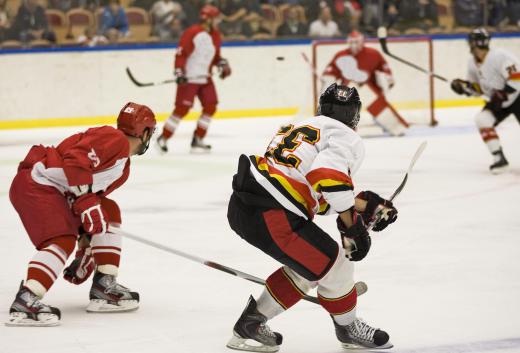Getting ready to play hockey means not only getting in shape, but also making certain you have the right types of hockey equipment. There are three variants of the sport: field, rink and ice hockey. Hockey equipment depends largely on what type you play.
The primary differences between field hockey and the two other types is that field hockey is played with a ball and requires shoes with cleats to prevent slipping. Other equipment for field hockey includes shin and knee padding. Field hockey requires a stick for play, and depending on the level at which you are playing, may require you to bring your own ball.

When most people think of hockey, they think of ice hockey. Your first hockey equipment requirement for this sport is well fitting ice skates. Choosing the right skates is an important consideration because the wrong skates can cause painful blisters. Recent studies also suggest that you should choose synthetic rather than cotton or wool socks, as synthetics tend to cause less blistering.

For rink hockey equipment, you will need in-line roller skates or regular roller skates instead of ice skates. Rink hockey with in-line skates seems to be the more popular choice these days, as it is closer to ice hockey. Again, you should take some time to find a good fitting pair of skates. Roller skates can also cause foot discomfort or blistering if the fit is poor.

If you’re new to the field of hockey, hockey equipment expenses may be prohibitive. To cut down on expenses, you may want to consider purchasing used sticks or pads; just make sure not to sacrifice proper fit for economy’s sake. A complete set of used hockey equipment ranges between 200-400 US dollars (USD).
When choosing hockey equipment, stick choice is also important. Consider your height, as a hockey stick should fit you well. Sticks are available in the traditional wood, in fiberglass, or in metal. They also come in different weights and curve left, right, or straight. Choice may be partially determined by which position you play. Sports stores are excellent at helping players choose the appropriate stick.

Hockey can be a rough sport, so helmets for ice and rink hockey are important. Mouth guards are equally important to protect your teeth. Jockstraps for men can also make collisions far less painful and less memorable. Potential hockey players can also purchase protective body gear and neck protectors.
The last consideration in choosing hockey equipment is the puck itself. Generally, the level of play determines the size. Experienced players use smaller pucks.

Standard pucks are about one inch (2.54cm) thick and three inches (7.62 cm) in diameter. Training pucks may be larger. If you are new to the sport, you may want to purchase a few pucks for practice. Organized games usually provide hockey equipment like pucks and nets.
